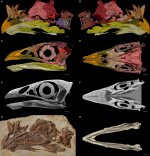Fred Ruhe
Well-known member

Han Hu, Yan Wang, Paul G. McDonald, Stephen Wroe, Jingmai K. O'Connor, Alexander Biarnason, Joseph J. Bevitt, Xuwei Yin, Xiaoting Zheng, Zhonghe Zhou & Roger B. J. Benson, 2022
Earliest evidence for fruit consumption and potential seed dispersal by birds
eLife. 11: e74751.
doi:10.7554/eLife.74751. PMID 35971758.
Abstract and free pdf: Earliest evidence for fruit consumption and potential seed dispersal by birds
The Early Cretaceous diversification of birds was a major event in the history of terrestrial ecosystems, occurring during the earliest phase of the Cretaceous Terrestrial Revolution, long before the origin of the bird crown-group. Frugivorous birds play an important role in seed dispersal today. However, evidence of fruit consumption in early birds from outside the crown-group has been lacking. Jeholornis is one of the earliest-diverging birds, only slightly more crownward than Archaeopteryx, but its cranial anatomy has been poorly understood, limiting trophic information which may be gleaned from the skull. Originally hypothesised to be granivorous based on seeds preserved as gut contents, this interpretation has become controversial. We conducted high-resolution synchrotron tomography on an exquisitely preserved new skull of Jeholornis, revealing remarkable cranial plesiomorphies combined with a specialised rostrum. We use this to provide a near-complete cranial reconstruction of Jeholornis, and exclude the possibility that Jeholornis was granivorous, based on morphometric analyses of the mandible (3D) and cranium (2D), and comparisons with the 3D alimentary contents of extant birds. We show that Jeholornis provides the earliest evidence for fruit consumption in birds, and indicates that birds may have been recruited for seed dispersal during the earliest stages of the avian radiation. As mobile seed dispersers, early frugivorous birds could have expanded the scope for biotic dispersal in plants, and might therefore explain, at least in part, the subsequent evolutionary expansion of fruits, indicating a potential role of bird–plant interactions in the Cretaceous Terrestrial Revolution.
Enjoy,
Fred
Earliest evidence for fruit consumption and potential seed dispersal by birds
eLife. 11: e74751.
doi:10.7554/eLife.74751. PMID 35971758.
Abstract and free pdf: Earliest evidence for fruit consumption and potential seed dispersal by birds
The Early Cretaceous diversification of birds was a major event in the history of terrestrial ecosystems, occurring during the earliest phase of the Cretaceous Terrestrial Revolution, long before the origin of the bird crown-group. Frugivorous birds play an important role in seed dispersal today. However, evidence of fruit consumption in early birds from outside the crown-group has been lacking. Jeholornis is one of the earliest-diverging birds, only slightly more crownward than Archaeopteryx, but its cranial anatomy has been poorly understood, limiting trophic information which may be gleaned from the skull. Originally hypothesised to be granivorous based on seeds preserved as gut contents, this interpretation has become controversial. We conducted high-resolution synchrotron tomography on an exquisitely preserved new skull of Jeholornis, revealing remarkable cranial plesiomorphies combined with a specialised rostrum. We use this to provide a near-complete cranial reconstruction of Jeholornis, and exclude the possibility that Jeholornis was granivorous, based on morphometric analyses of the mandible (3D) and cranium (2D), and comparisons with the 3D alimentary contents of extant birds. We show that Jeholornis provides the earliest evidence for fruit consumption in birds, and indicates that birds may have been recruited for seed dispersal during the earliest stages of the avian radiation. As mobile seed dispersers, early frugivorous birds could have expanded the scope for biotic dispersal in plants, and might therefore explain, at least in part, the subsequent evolutionary expansion of fruits, indicating a potential role of bird–plant interactions in the Cretaceous Terrestrial Revolution.
Enjoy,
Fred
Last edited:




